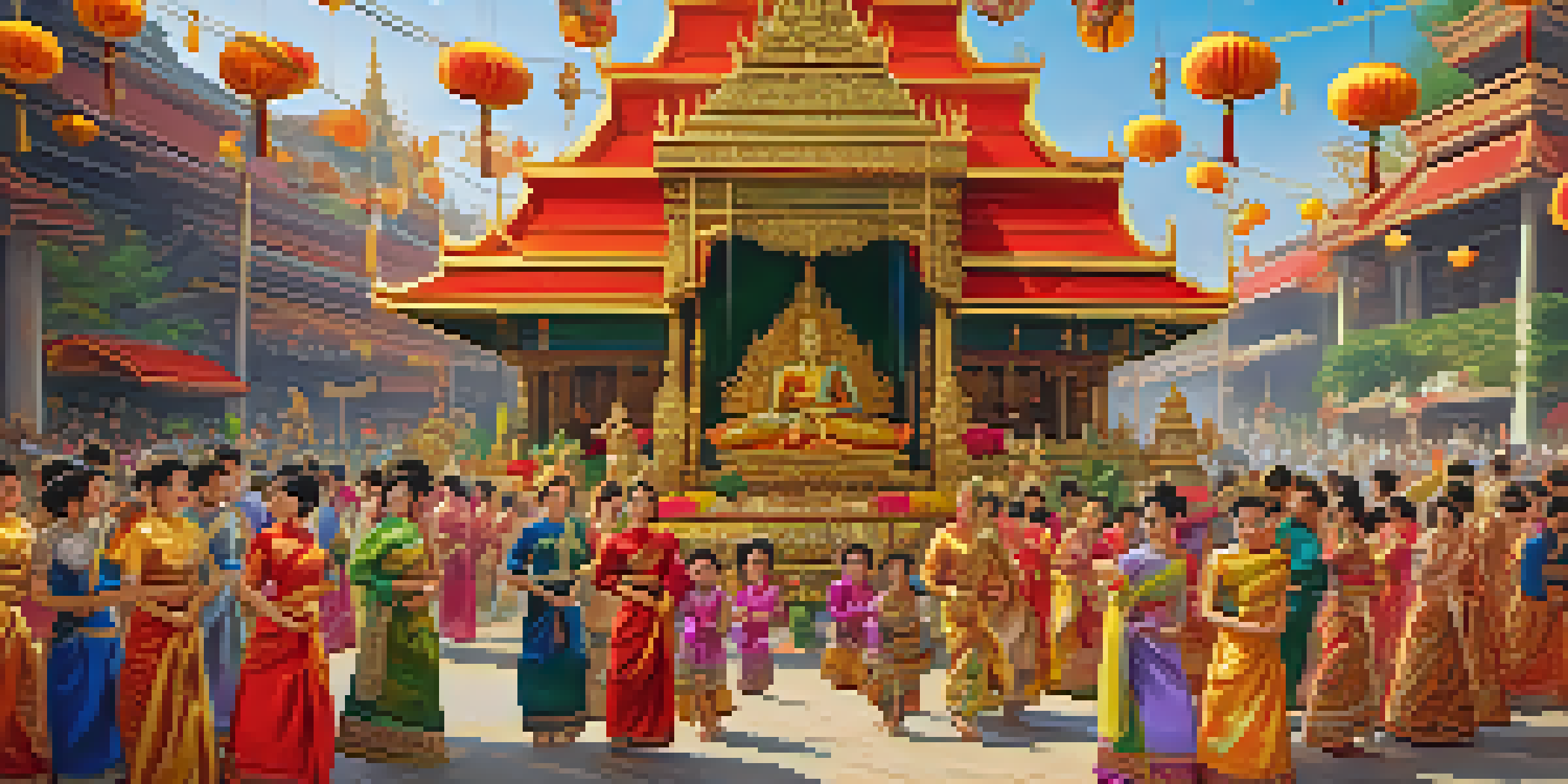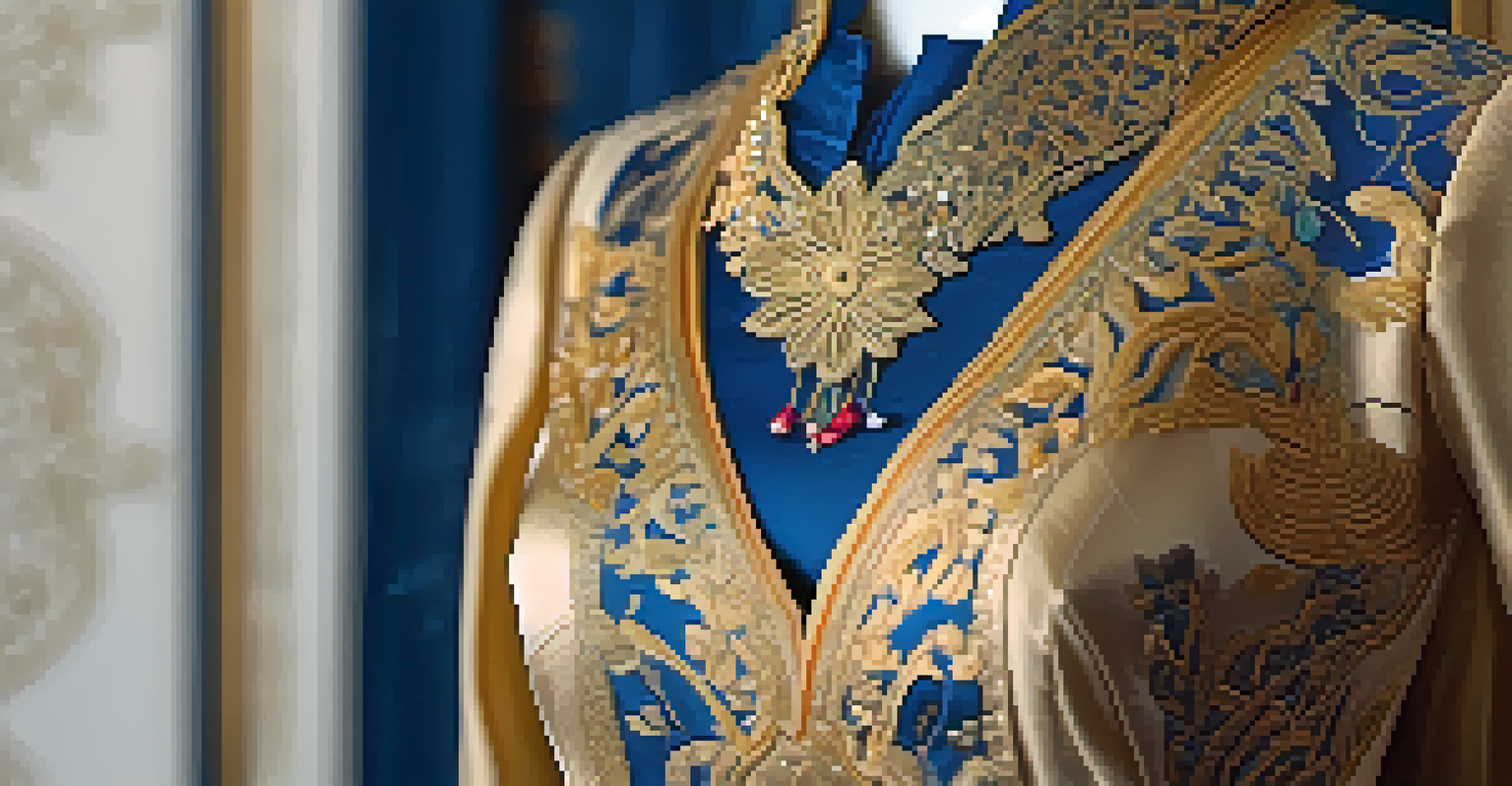Symbolism in Traditional Thai Clothing: What It Means

Understanding Traditional Thai Clothing and Its Origins
Traditional Thai clothing, known for its vibrant colors and intricate designs, reflects the rich cultural heritage of Thailand. It has evolved over centuries, influenced by various historical events and cultural exchanges. Each piece of clothing tells a story, often linking wearers to their family, community, and history.
Clothing is a form of self-expression, a way to tell your story without saying a word.
The fabric and styles used in traditional attire are often symbolic, representing more than just aesthetic choices. For instance, silk, a common material, symbolizes wealth and nobility, as it was historically reserved for royals and the elite. The craftsmanship involved in making these garments also showcases the skills passed down through generations, emphasizing the importance of tradition.
Understanding the origins of these garments helps appreciate their significance. Traditional Thai clothing is often worn during festivals, religious ceremonies, and important life events, underscoring its role in cultural identity and continuity.
The Colors of Thai Clothing and Their Meanings
Colors play a vital role in traditional Thai clothing, often imbued with specific meanings that can reflect the wearer's personal beliefs or social status. Bright colors like gold and red symbolize prosperity and good fortune, making them popular choices for celebrations and weddings.

Conversely, darker hues may be worn during mourning periods, showcasing a sensitivity to the emotional weight of the occasion. In this way, the choice of color is not merely aesthetic but a reflection of social customs and the emotional landscape of Thai society.
Cultural Significance of Thai Clothing
Traditional Thai clothing embodies rich cultural heritage, reflecting personal and communal identities through its designs and materials.
Moreover, the cultural significance of colors extends beyond clothing; they are intertwined with Thai traditions and rituals, often linked to Buddhist beliefs. This deep connection between color and meaning enhances the overall symbolism of traditional Thai attire.
Patterns and Textures: Telling Stories Through Design
The intricate patterns and textures found in traditional Thai clothing often carry deep meanings and represent various cultural narratives. For example, motifs like lotus flowers symbolize purity, while elephants represent strength and good luck, both integral to Thai culture.
Fashion is the armor to survive the reality of everyday life.
Each design element serves a purpose, often reflecting the natural environment, religious beliefs, or historical events. This storytelling aspect of clothing design not only beautifies the garment but also honors the culture and the stories of those who wear them.
Additionally, the textures used in these garments—from smooth silks to rough cotton—can evoke different emotions and associations. This interplay between pattern, texture, and meaning enriches the wearer's experience and connection to their heritage.
The Role of Accessories in Thai Traditional Attire
Accessories in traditional Thai clothing are not just embellishments; they are steeped in symbolism and cultural significance. Items like the 'chada' (headdress) worn by women can signify marital status or social standing, while men's accessories often denote rank and authority.
Jewelry also plays an essential role, with certain pieces believed to offer protection or bring good fortune. The materials used, such as gold or silver, are often chosen for their perceived auspicious qualities, making each accessory a carefully considered addition to the outfit.
Regional Variations in Attire
Thailand's diverse regions showcase unique styles and fabrics in traditional clothing, highlighting local customs and adaptability.
The thoughtful selection of accessories enhances the overall meaning of the clothing, providing deeper insights into the wearer's identity and social context. This highlights how traditional Thai fashion is a collective expression of culture and individual significance.
The Influence of Regional Variations on Thai Clothing
Thailand is a country rich in diversity, and this is reflected in its traditional clothing, which varies significantly across regions. Each area has developed its unique styles, colors, and fabrics, influenced by local customs, climates, and available resources.
For instance, the northern regions may favor heavier fabrics and complex designs, while southern attire tends to be lighter and simpler, reflecting the tropical climate. These differences not only showcase the beauty of regional culture but also highlight the adaptability of traditional clothing.
Understanding these regional variations adds depth to our appreciation of Thai clothing, revealing how geography and culture intertwine to create a vibrant tapestry of traditional attire across the country.
Modern Adaptations of Traditional Thai Clothing
In recent years, traditional Thai clothing has seen a resurgence, with many designers incorporating modern elements while respecting cultural significance. This blending of styles allows younger generations to connect with their heritage while expressing their individuality.
For example, traditional motifs may be found on contemporary dresses and suits, making them suitable for both formal events and everyday wear. Such adaptations keep the cultural relevance of traditional clothing alive, ensuring it resonates with today's society.
Modern Adaptations Preserve Heritage
Recent trends in fashion have led to modern adaptations of traditional Thai clothing, allowing younger generations to connect with their cultural roots.
This evolution reflects a broader trend of cultural appreciation, where traditional attire is embraced not just as costume, but as a living expression of Thai identity that continues to evolve while honoring its roots.
The Importance of Preserving Traditional Thai Clothing
Preserving traditional Thai clothing is crucial for maintaining cultural identity and heritage. As globalization influences fashion trends, the risk of losing these unique styles becomes more significant, making awareness and appreciation essential.
Efforts to promote traditional attire through education, cultural events, and fashion shows play a vital role in keeping these customs alive. By showcasing the beauty and significance of traditional clothing, future generations can understand and value their rich cultural history.

Moreover, preserving traditional Thai clothing helps foster a sense of pride within the community. It encourages individuals to explore their roots, ensuring that the symbolism and craftsmanship of these garments continue to be celebrated and passed down.